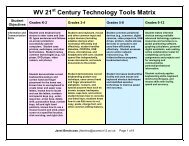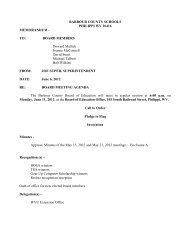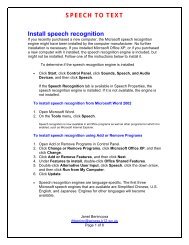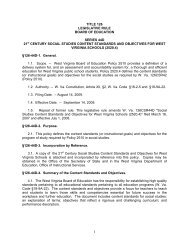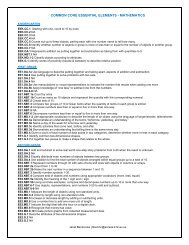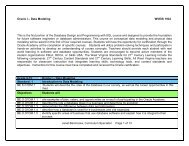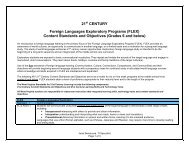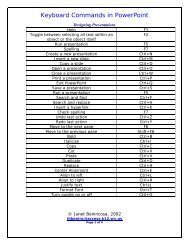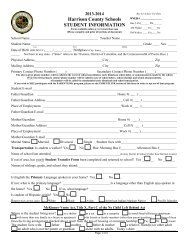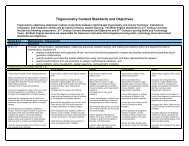CommonCore Essential Elements - ELA
CommonCore Essential Elements - ELA
CommonCore Essential Elements - ELA
You also want an ePaper? Increase the reach of your titles
YUMPU automatically turns print PDFs into web optimized ePapers that Google loves.
SECOND GRADECOMMON CORE ESSENTIAL ELEMENTS – English Language ArtsEERL.2.1 Answer who and where questions to demonstrate understanding of details in a familiar text.EERL.2.2 Retell familiar stories from diverse cultures, including two or more elements from different parts of the story.EERL.2.3 Identify the actions and feelings of the characters in a familiar story.EERL.2.4 Identify rhyming words or repeated phrases in a familiar story, poem, or song.EERL.2.5 Determine the beginning and ending of a story.EERL.2.6 Identify the speakers in a dialogue.EERL.2.7 Use illustrations in print or digital text to identify characters and settings.EERL.2.8 NAEERL.2.9 Identify similarities in two versions of the same story.EERL.2.10 This Literature <strong>Essential</strong> Element references all elements above.EERI.2.1 Answer who and what questions to demonstrate understanding of details in a familiar text.EERI.2.2 Identify the topic of the text.EERI.2.3 Sequence at least two steps in a procedure or ideas/incidents n an event.EERI.2.4 Identify words related to a topic of a text.EERI.2.5 Locate facts or information in a familiar text.EERI.2.6 Identify purpose of a text.EERI.2.7 Demonstrate understanding of how images relate to a familiar informational text.EERI.2.8 NAEERI.2.9 Identify a common element between two texts.EERI.2.10 This Informational Text <strong>Essential</strong> Element references all elements above.EERF.2.3a-c Apply letter-sound & word analysis skills decoding words. In context, identify 18 or moreEERF.2.3d-e Identify the beginning sound of familiar words beginning with a single consonant sound.EERF.2.3f Recognize 10 or more written words.EERF.2.4 Read a shared-reading selection. (The ES does not address fluency, but does address listening.)EEW.2.1 Select a book and write, draw, or dictate to state an opinion about it & one reason to support the opinion.EEW.2.2 Select a topic and use drawing, dictating, or writing to compose a message with one fact about the topic.EEW.2.3 Select an event or personal experience and use drawing, writing, or dictating to compose a message about it.EEW.2.4 (Begins in grade 3)EEW.2.5 With guidance & support from adults & peers, add more information to own drawing, dictating, or writing.EEW.2.6 With guidance & support from adults & peers, use technology to produce and publish writing.EEW.2.7 Participate in shared writing projects – communicate a message to add information.EEW.2.8 Identify information related to personal experiences and answer simple questions about those experiences.EEW.2.9-EEW.2.10 (Begins in grade 4)- (Begins in grade 3)EESL.2.1a Engage in multiple-turn exchanges with peers and adults in small groups.EESL.2.1b Build on comments or topics initiated by adults and peers.EESL.2.1c Ask questions related to a prescribed topic or text.EESL.2.2 Ask & answer questions about key details from text or information presented orally or through other media.EESL.2.3 Answer questions about what a speaker says.EESL.2.4 Identify a photograph or object that reflects a personal experience and tell one detail about it.EESL.2.5 Select a visual, audio, or tactual representation to depict an experience, thoughts, or feelings.EESL.2.6 Communicate to provide clarification.EEL.2.1a Produce all letters.EEL.2.1b Use frequently occurring nouns.EEL.2.1c Use frequently occurring pronouns to refer to self and others.EEL.2.1d Use frequently occurring verbs.EEL.2.1e Use frequently occurring adjectives.EEL.2.1f Link two or more words together in communication.EEL.2.2 Capitalize the first letter of familiar names.EEL.2.2b-c NAEEL.2.2d Identify printed rhyming words with the same spelling pattern.EEL.2.2e Consult print in the environment to support reading and spelling.EEL.2.3 Use informal language when communicating.EEL.2.4a-b Use newly acquired vocabulary.EEL.2.4c Sort words into familiar categories.EEL.2.4d NAEEL.2.4e Ask about an unknown word.EEL.2.5a Identify real-life connections between words and their use.EEL.2.5b Identify the function of common nouns.EEL.2.6 Use adjectives and adverbs from texts that have been read.Janet Benincosa jhbeninc@access.k12.wv.us




